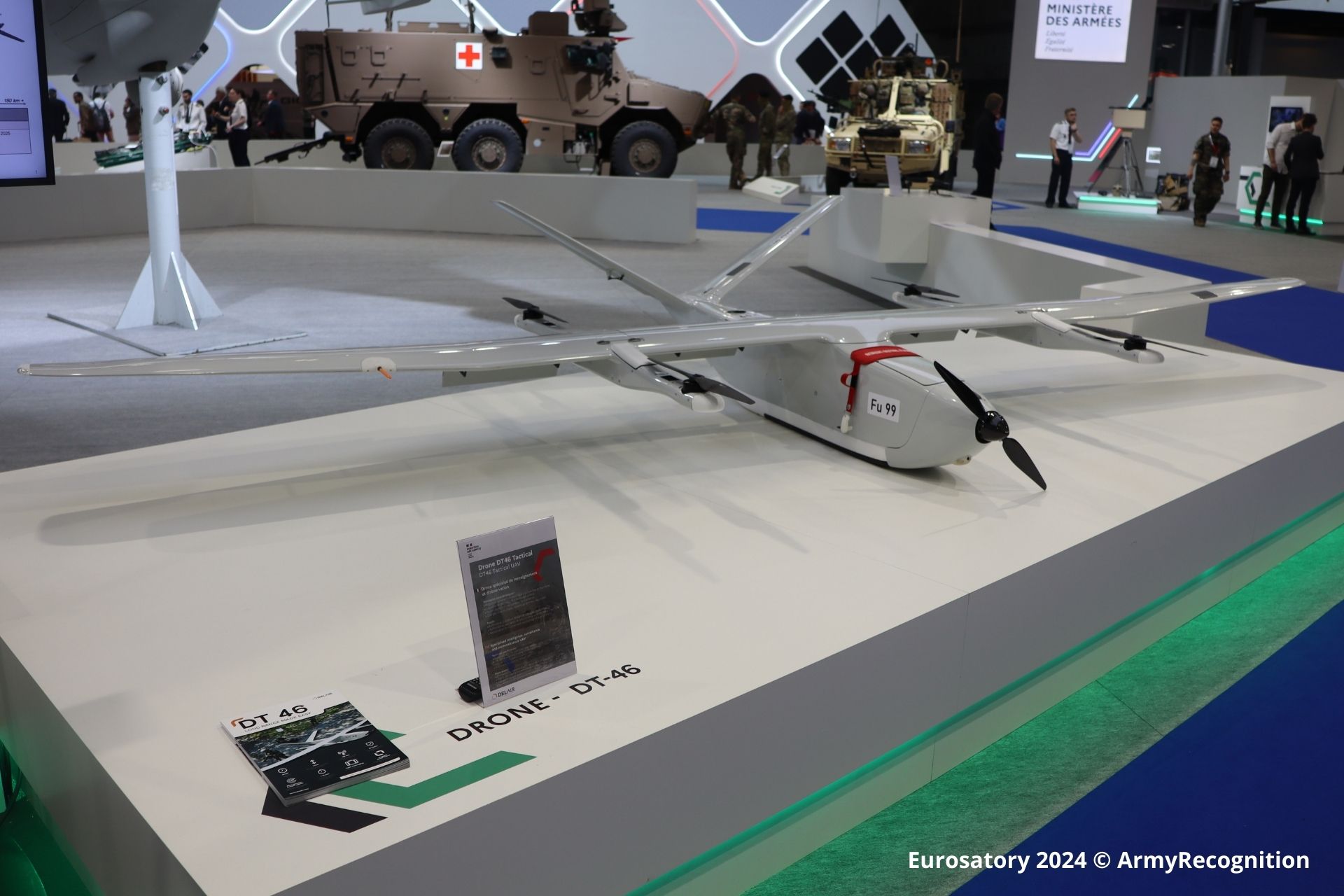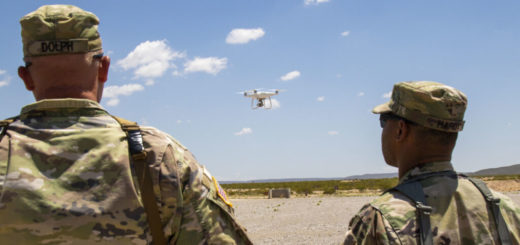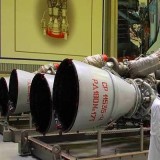First Deployment of French DT-46 Drone in Romania Strategic Support for CAESAr Artillery Systems

{loadposition bannertop}
{loadposition sidebarpub}
The French Army is preparing for the first operational deployment of the DT-46 drone in an external theater, as reported by Opex360 on January 15, 2025. This innovative system is designed to meet the needs of modern artillery regiments, particularly in supporting CAESAr artillery systems. Developed by Delair and showcased at the Eurosatory defense exhibition, the DT-46 reflects France’s broader strategy to modernize its land forces, drawing on lessons from the conflict in Ukraine. The latter has highlighted the critical role of drones in artillery operations and their ability to redefine tactical approaches on the battlefield.
Follow Army Recognition on Google News at this link
The DT-46’s evaluation confirmed its ability to discreetly detect, recognize, and identify targets, making it essential for precise CAESAr artillery strikes (Picture source: ArmyRecognition)
Thanks to its adaptable rotative arms, the DT-46 offers exceptional operational flexibility. It can operate in vertical takeoff and landing (VTOL) mode or as a fixed-wing drone. It boasts a range of 100 kilometers and an endurance of up to six hours in fixed-wing configuration or approximately three and a half hours in VTOL mode. The DT-46 can carry payloads of up to 5 kg, including advanced optronic sensors, LIDAR systems, and thermal cameras, making it well-suited for intelligence, surveillance, and target acquisition missions.
Deploying drones within artillery units provides a decisive advantage by delivering precise, real-time intelligence essential for planning and executing strikes. These systems reduce the need to send observer teams into hostile zones, thus lowering human risk while increasing the speed and efficiency of operations. By integrating the DT-46 into the ATLAS system, which centralizes command, logistics, and intelligence functions, the French Army significantly shortens the targeting process. This technological synergy also enhances strike precision, helping to minimize collateral damage.
The DT-46 complies with STANAG 4609 standards, ensuring seamless integration with existing military systems, such as the SCORPION combat information system and the DRAKO ground control platform. This interoperability positions the DT-46 as a key element in network-centric warfare, where drones, artillery systems, and other assets work together to deliver a comprehensive operational picture. In this context, the DT-46 acts as a force multiplier, boosting the capabilities of artillery regiments in complex and dynamic environments.
The conflict in Ukraine has directly influenced the development of such technologies, underscoring the essential role of drones in intelligence gathering, force protection, and real-time targeting adjustments. Drones like the DT-46 extend the range of artillery units, enabling them to engage targets beyond the line of sight with greater precision. This capability is particularly important for regiments equipped with CAESAr systems, known for their mobility and effectiveness in diverse tactical scenarios.
The DT-46 underwent a technical-operational evaluation (EVTO) led by the French Army’s Technical Section (STAT) and the 35th Airborne Artillery Regiment (RAP), which confirmed its strong performance. The trials highlighted its ability to deliver rapid detection, recognition, and identification while maintaining optimal discretion. These features make the DT-46 an invaluable asset for CAESAr batteries, offering immediate precision for effective and coordinated artillery strikes.
To accelerate the DT-46’s deployment, the Ministry of Armed Forces adopted a streamlined approach, allowing the Aeronautical Maintenance Directorate (DMAé) to acquire fifty units quickly. These drones will be distributed across several artillery regiments and included in training programs at the Drone School. The first operational deployment, planned in Romania under Mission Aigle, marks a pivotal step in the real-world application of this technology. The French Army will also participate in the Dacian Spring exercise alongside the 7th Armored Brigade, demonstrating the DT-46’s capabilities in a strategic theater in Eastern Europe.
In recent years, France has significantly expanded its drone capabilities in both military and civilian domains. Within defense, it actively participates in the Eurodrone program in collaboration with Germany, Spain, and Italy, aiming to develop a European MALE (Medium Altitude Long Endurance) drone for intelligence, surveillance, and reconnaissance missions.
At the same time, French companies such as Naval Group are advancing naval drone technologies, positioning France as a potential leader in this sector. Additionally, the Ministry of Armed Forces formalized the “Defense Aerial Drones Pact,” bringing together key French industries to build a sovereign capability tailored to the needs of its armed forces.
These initiatives underscore France’s commitment to becoming a leader in drone development and integration, addressing the demands of modern conflicts and advancing surveillance capabilities in both military and civilian contexts.

{loadposition bannertop}
{loadposition sidebarpub}
The French Army is preparing for the first operational deployment of the DT-46 drone in an external theater, as reported by Opex360 on January 15, 2025. This innovative system is designed to meet the needs of modern artillery regiments, particularly in supporting CAESAr artillery systems. Developed by Delair and showcased at the Eurosatory defense exhibition, the DT-46 reflects France’s broader strategy to modernize its land forces, drawing on lessons from the conflict in Ukraine. The latter has highlighted the critical role of drones in artillery operations and their ability to redefine tactical approaches on the battlefield.
The DT-46’s evaluation confirmed its ability to discreetly detect, recognize, and identify targets, making it essential for precise CAESAr artillery strikes (Picture source: ArmyRecognition)
Thanks to its adaptable rotative arms, the DT-46 offers exceptional operational flexibility. It can operate in vertical takeoff and landing (VTOL) mode or as a fixed-wing drone. It boasts a range of 100 kilometers and an endurance of up to six hours in fixed-wing configuration or approximately three and a half hours in VTOL mode. The DT-46 can carry payloads of up to 5 kg, including advanced optronic sensors, LIDAR systems, and thermal cameras, making it well-suited for intelligence, surveillance, and target acquisition missions.
Deploying drones within artillery units provides a decisive advantage by delivering precise, real-time intelligence essential for planning and executing strikes. These systems reduce the need to send observer teams into hostile zones, thus lowering human risk while increasing the speed and efficiency of operations. By integrating the DT-46 into the ATLAS system, which centralizes command, logistics, and intelligence functions, the French Army significantly shortens the targeting process. This technological synergy also enhances strike precision, helping to minimize collateral damage.
The DT-46 complies with STANAG 4609 standards, ensuring seamless integration with existing military systems, such as the SCORPION combat information system and the DRAKO ground control platform. This interoperability positions the DT-46 as a key element in network-centric warfare, where drones, artillery systems, and other assets work together to deliver a comprehensive operational picture. In this context, the DT-46 acts as a force multiplier, boosting the capabilities of artillery regiments in complex and dynamic environments.
The conflict in Ukraine has directly influenced the development of such technologies, underscoring the essential role of drones in intelligence gathering, force protection, and real-time targeting adjustments. Drones like the DT-46 extend the range of artillery units, enabling them to engage targets beyond the line of sight with greater precision. This capability is particularly important for regiments equipped with CAESAr systems, known for their mobility and effectiveness in diverse tactical scenarios.
The DT-46 underwent a technical-operational evaluation (EVTO) led by the French Army’s Technical Section (STAT) and the 35th Airborne Artillery Regiment (RAP), which confirmed its strong performance. The trials highlighted its ability to deliver rapid detection, recognition, and identification while maintaining optimal discretion. These features make the DT-46 an invaluable asset for CAESAr batteries, offering immediate precision for effective and coordinated artillery strikes.
To accelerate the DT-46’s deployment, the Ministry of Armed Forces adopted a streamlined approach, allowing the Aeronautical Maintenance Directorate (DMAé) to acquire fifty units quickly. These drones will be distributed across several artillery regiments and included in training programs at the Drone School. The first operational deployment, planned in Romania under Mission Aigle, marks a pivotal step in the real-world application of this technology. The French Army will also participate in the Dacian Spring exercise alongside the 7th Armored Brigade, demonstrating the DT-46’s capabilities in a strategic theater in Eastern Europe.
In recent years, France has significantly expanded its drone capabilities in both military and civilian domains. Within defense, it actively participates in the Eurodrone program in collaboration with Germany, Spain, and Italy, aiming to develop a European MALE (Medium Altitude Long Endurance) drone for intelligence, surveillance, and reconnaissance missions.
At the same time, French companies such as Naval Group are advancing naval drone technologies, positioning France as a potential leader in this sector. Additionally, the Ministry of Armed Forces formalized the “Defense Aerial Drones Pact,” bringing together key French industries to build a sovereign capability tailored to the needs of its armed forces.
These initiatives underscore France’s commitment to becoming a leader in drone development and integration, addressing the demands of modern conflicts and advancing surveillance capabilities in both military and civilian contexts.






